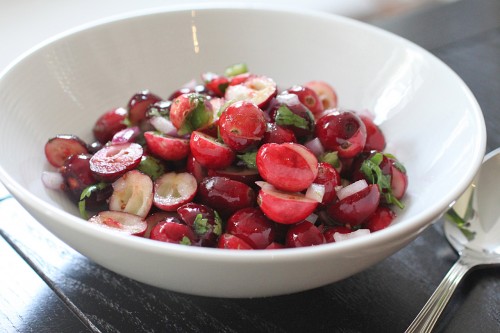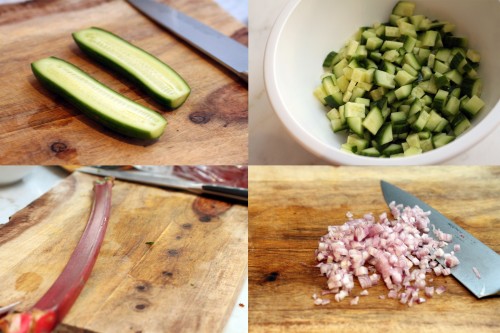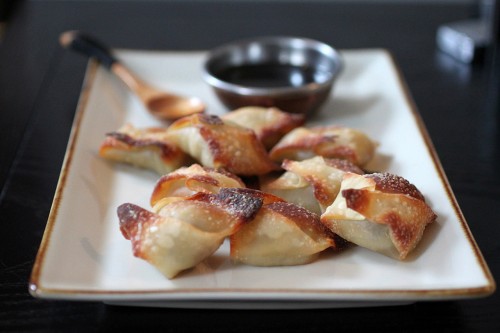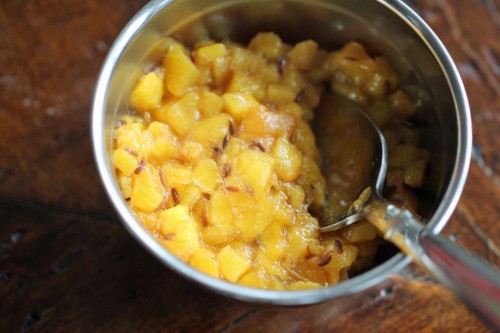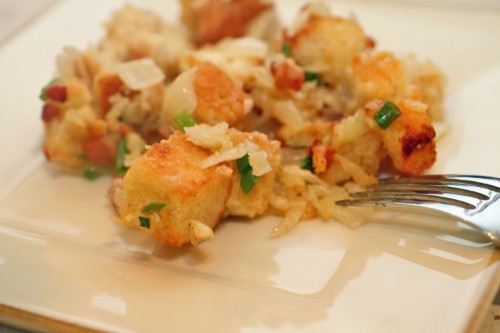Baked Trini Wontons
I’m just going to say it to get it out of the way. Frying just tastes better. It does. There is no other way to get that perfect, even texture, signature crunch, and lovely fried flavor…BUT if you can pretend like fried wontons never existed or not do some sort of unfair comparison of a fried wonton vs. a baked one, these are absolutely delicious (and, of course, a little better for you and your waistline).
I first came across the fried and soup version of these because of my husband and his wonton cravings. The Chinese influence on Trinidad is evident here as it combines traditional Asian flavors with pops of West Indian influence – particularly the scotch bonnet or habanero. What I love about this recipe is that it is ridiculously versatile – you can, of course, deep-fry these (as I do for company), keep them frozen and pop them in the oven for a weeknight appetizer for the family, throw a few of them into a brothy vegetable soup to cook with and add a bit of flavor, or even just use the stuffing mixture with some breadcrumbs for a nice, spicy pork meatball. AND, if you want to use ground chicken, beef or shrimp instead of pork, the recipe still works great.
I got a bit crazy while making these and tested out the wontons at 25 degree intervals in the oven, on both convention and convection settings, to figure out which creates the best texture (crazy, I know, but effective!). Deep-frying, because of the circulation of hot oil, cooks evenly and quickly, so I ended up going with a relatively high temperature (425° F) and using the convection setting (for circulating air) to yummy, crispy results. These don’t take too long to cook, and what this does is prevent the wonton dough from getting too chewy, which seemed to happen at the lower temperatures. Again, these do freeze up really easily, but make sure to bring to room temp before baking (if you’re frying, straight from the freezer is fine). Easy weeknight app, little hors d’oeuvres for entertaining…this wonton is spicy, flavorful, crunchy and satisfying – Enjoy!
Ingredients
Yields 24 to 30 wontons
2 tbsps vegetable oil
1 large shallot, finely chopped
½ habanero pepper, seeded and minced
1 ½” piece of ginger, minced (~½ tsp)
1 scallion, minced
2-3 garlic cloves, minced
½ lb ground pork, room temperature
zest of 1 lime
¾ tsp soy sauce
½ tsp Worcestershire sauce
2 tbsps chopped fresh cilantro
salt and freshly ground black pepper
24-30 wonton skins
Olive oil or cooking spray
Procedure
Preheat the oven to 425° F on the convection setting for optimal texture. If you don’t have an oven that has convection capabilities, preheat the regular oven to 450° F.
Heat a small pan over medium heat. Add the vegetable oil and then add the shallot, pepper, ginger and scallion. Add a little salt to draw out the moisture and sauté for 3 to 4 minutes until the shallot is translucent. Add the minced garlic and sauté for another minute until the garlic is fragrant. Remove from the heat and let cool.
Using a large bowl, mix together the pork with the cooled shallot mixture, lime zest, soy sauce, Worcestershire, cilantro and season with salt and freshly ground pepper (remember the soy and Worcestershire are salty so you might not need much). You can always quickly sauté a tiny patty to check seasoning.
Set up a little work station for yourself with a cutting board, a small bowl with water, a towel to wipe your hands, the wonton skins, and the pork mixture. I like to make these 3 to 5 at a time.
Lay out the wonton skins on your cutting board, and then spoon even amounts of the pork mixture in the center of each. You don’t want to overstuff so test out the first one to see what the right amount of the pork mixture is.
Dip your fingertips in the water bowl, and then wipe across the four edges of the wonton skin with it so they’re wet. Fold one corner over to the other and press down the corner and sides to form a triangle. Don’t be afraid – press hard! Or else your stuffing will ooze out. Bring the other two edges up to meet, using more water if necessary, and press together. Place on a parchment-lined baking sheet that has been greased with either olive oil or spray.
Repeat until all of the wontons have been formed. Spray each wonton or brush with olive oil and place in the oven. Bake for 8 to 10 minutes until deep, golden brown. Serve warm with your dipping sauce of choice.
*If you’ve frozen or refrigerated these, make sure they come up to room temperature before baking.

